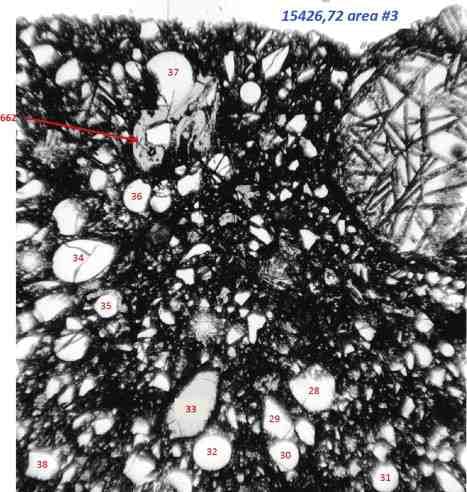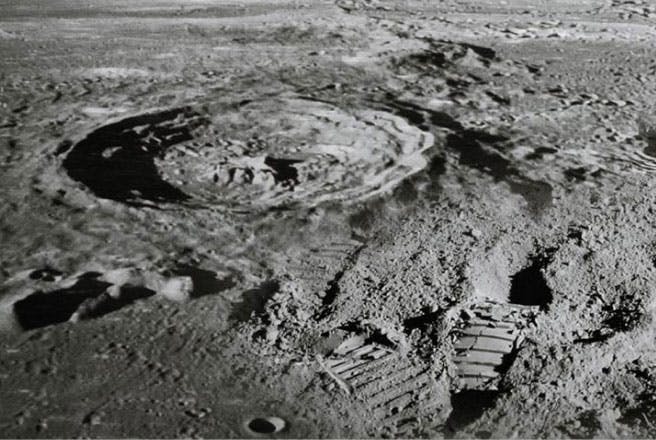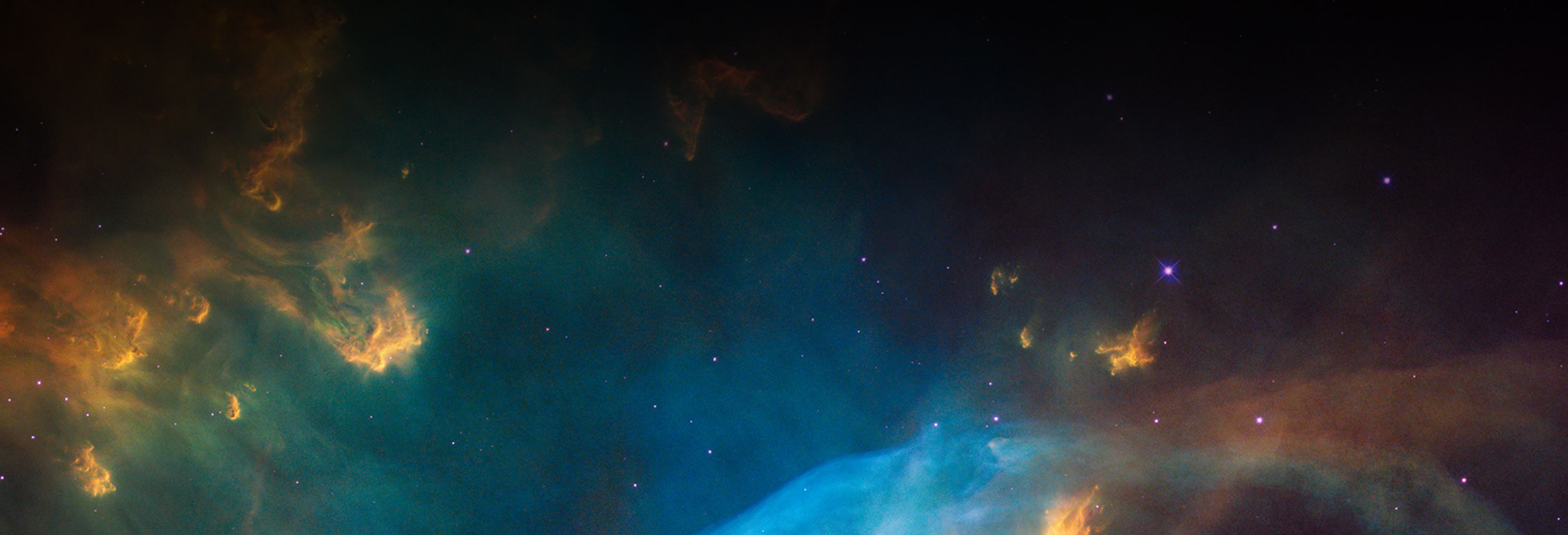
Lunar Samples Data Rescue
IEDA Data Rescue Mini-Award: Lunar Samples
An enduring legacy of the Apollo program is the lunar sample collection that is currently maintained and curated at Johnson Space Center in Houston, TX. These samples, obtained at tremendous cost and great risk, are the only samples that have ever been returned by astronauts from the surface of another planetary body. However, despite the fastidious care and effort with which lunar samples are stored, handled, distributed and accounted for, and the wealth of published and unpublished data on these samples, there is currently no searchable digital database for the geochemistry of lunar samples.
The goal of this project is to assemble the major element, trace element, volatile element and isotopic composition for two unique types of lunar samples -- lunar volcanic glasses (LVG) and lunar impact glasses (LIG). It is generally agreed that LVGs provide our best constraints on the chemical composition and mineralogy of the Moon's mantle. The LIGs provide lunar scientists with information about the wide compositional range of upper crustal materials on the Moon.
The Science Team includes: John Delano (University of Albany, NY), Erik Hauri (Carnegie Institution of Washington, DC), Alberto Saal (Brown University), Charles Shearer (University of New Mexico). Data products will be listed on this page when completed.
Major Element Analyses
Sample 15426
Delano, John W. (2013) Electron microprobe analyses of Apollo 15 green and yellow glasses from Lunar sample 15426,72. Integrated Earth Data Applications (IEDA). doi.org/10.1594/IEDA/100410

Scanned and labeled image of a thin section for lunar sample 15426,72. Copyright: Hsu et al. (2015). Rescue of long-tail data from the ocean bottom to the Moon: IEDA Data Rescue Mini-Awards. GeoResJ. 6. 10.1016/j.grj.2015.02.012.
Sample 74220
Delano, John W. (2013) Electron microprobe analyses of Apollo 17 volcanic orange glasses from Lunar sample 74220,128. Integrated Earth Data Applications (IEDA). doi.org/10.1594/IEDA/100411
Sample 60014
Delano, John W. (2014) Electron microprobe analyses of Apollo 16 glasses from Lunar sample 60014. Integrated Earth Data Applications (IEDA). doi.org/10.1594/IEDA/100431
Delano, John W. (2014), Maps showing locations of glasses analyzed from Apollo 16, sample 60014. Integrated Earth Data Applications (IEDA). doi.org/10.1594/IEDA/100455
Sample 64001
Delano, John W. (2014) Electron microprobe analyses of Apollo 16 glasses from Lunar sample 64001. Integrated Earth Data Applications (IEDA). doi.org/10.1594/IEDA/100430
Delano, John W. (2014), Maps showing locations of glasses analyzed from Apollo 16, sample 64001. Integrated Earth Data Applications (IEDA). doi.org/10.1594/IEDA/100456
High-Ti glasses
Delano, John W. (2014) Electron microprobe analyses of Apollo 14 high-Ti glasses from Lunar samples 14301, 14307, 14313, 14049. Integrated Earth Data Applications (IEDA). doi.org/10.1594/IEDA/100429
Additional Maps
Delano, John W. (2014) Maps showing locations of glasses analyzed from lunar meteorite ALHA 81005, 8. Integrated Earth Data Applications (IEDA). doi.org/10.1594/IEDA/100457
John Delano has scanned and labeled the original non-digital images of thin sections and accompanying major element datasets. This will allow future investigators to identify and reanalyze specific grains from samples that are currently archived at the Johnson Space Center.
References
Chen H.K., Delano, J.W., Lindsley, D.H. (1982) Chemistry and phase relations of VLT volcanic glasses from Apollo 14 and Apollo 17. Proceedings of the 13th Lunar and Planetary Science Conference, J. Geophysical Research Supplement, 88, A171-A181. doi.org/10.1029/JB087iS01p0A171
Delano, J.W. (1979) Apollo 15 green glass: Chemistry and possible origin. Geochimica et Cosmochimica Acta, suppl. 11, Proceedings of the 10th Lunar Planetary Science Conference, 1, 275-300. 1979LPSC...10..275D
Delano J.W., Lindsley D.H., Ma M.-S., and Schmitt R.A. (1982) The Apollo 15 yellow impact glasses: Chemistry, petrology, and exotic origin. Journal of Geophysical Research: Solid Earth, v 87(S01), p. A159-A170. doi.org/10.1029/JB087iS01p0A159
Delano, J.W. (1986) Pristine lunar glasses: Criteria, data, and implications. Journal of Geophysical Research, 91, B4, D201-D213. doi.org/10.1029/JB091iB04p0D201
Delano J.W. (1988) Apollo 14 regolith breccias: Different glass populations and their potential for charting space/time variations. Proceedings of the 16th Lunar and Planetary Science Conference, Cambridge University Press, p. 59-65. 1988LPSC...18...59D
Delano J.W. (1992) Major-element compositions of impact glasses from lunar meteorites (ALHA81005; MAC88105) and Apollo 16 regolith (64001): A comparison. Geochimica et Cosmochimica Acta, 54, 3019-3029. doi.org/10.1016/0016-7037(91)90470-P
Delano J.W., Zellner N.E.B., Barra F., Olson E., Swindle T.E., Tibbets N.J., Whittet D.C.B. (2007) An integrated approach to understanding Apollo 16 impact glasses: Chemistry, isotopes, and shape. Meteoritics and Planetary Science, 42, 6, p. 993-1004. doi.org/10.1111/j.1945-5100.2007.tb01146.x
Delano J. W. (1996) Compositional range of primary magmas observed among the Apollo 17 orange volcanic glasses. Lunar Planetary Science-XXVII, p. 303-304. Lunar and Planetary Institute, Houston. 1996LPI....27..303D
Hughes S.S., Delano J.W., and Schmitt R.A. (1988) Apollo 15 yellow-brown volcanic glass: Chemistry and petrogenetic relations to green volcanic glass and olivine-normative mare basalts. Geochim. Cosmochim. Acta, 52, p. 2379-2391. doi.org/10.1016/0016-7037(88)90295-5
Hughes S.S., Delano J.W., and Schmitt R.A. (1989) Petrogenetic modeling of 74220 high-Ti orange volcanic glasses and the Apollo 11 and 17 high-Ti mare basalts. Proc. Lunar Planet. Sci. Conf. 19th, p. 175-188. 1989LPSC...19..175H
Spangler R.R., Warasila R., and Delano J.W. (1984) 39Ar-40Ar ages for the Apollo 15 green and yellow volcanic glasses. Journal of Geophysical Research, 89, supplement part 2, p. B487-B497. doi.org/10.1029/JB089iS02p0B487
Spangler R.R. and Delano J.W. (1984) History of the Apollo 15 yellow impact glass and sample 15426 and 15427. Journal of Geophysical Research, 89, supplement part 2, p. B478-B486. doi.org/10.1029/JB089iS02p0B478








